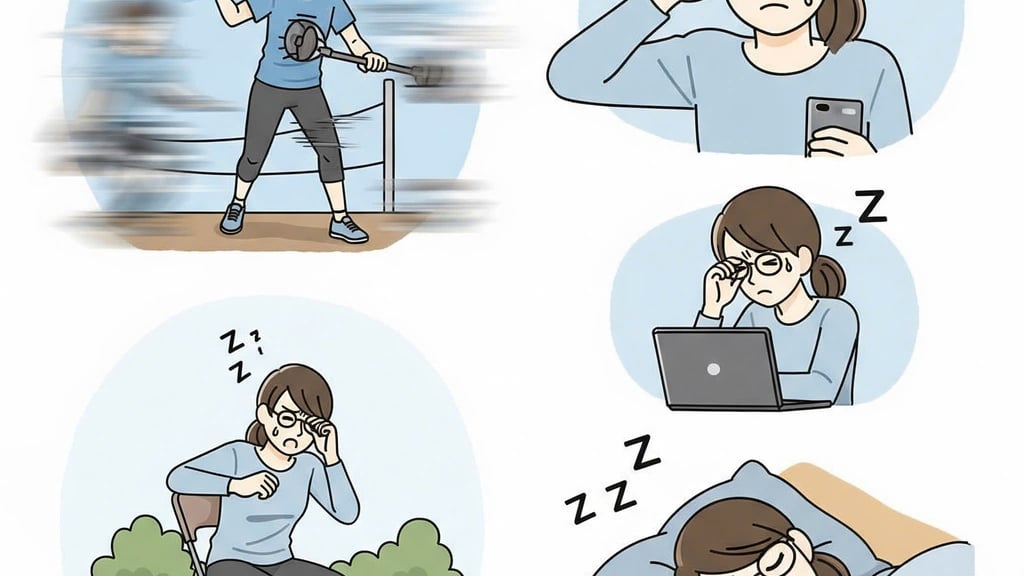Nearsightedness and sleep quality - The impact of nearsightedness on physical activity
3/7/20257 min read


Understanding Nearsightedness
Nearsightedness, commonly referred to as myopia, is a refractive error that results in the inability to see distant objects clearly. This vision condition occurs when the eyeball is too long, or the cornea has a steeper curvature than normal, leading to light entering the eye being focused in front of the retina instead of directly on it. Myopia commonly manifests in childhood or adolescence but can also develop later in life. Its prevalence has been steadily increasing globally, with some research suggesting that nearly 30% of adults exhibit some degree of myopia, a statistic that highlights the importance of understanding this condition.
Individuals suffering from nearsightedness often experience significant difficulty with tasks that require distance vision, such as reading road signs, viewing the television, or engaging in sports. This struggle can impose limitations on physical activities, potentially leading to a more sedentary lifestyle. Moreover, the condition can impact academic performance in children, as they may struggle to see the board or participate in various activities without correction. The impact of myopia reaches beyond visual challenges, influencing overall quality of life.
The onset of myopia can be attributed to a combination of genetic and environmental factors. Children with nearsighted parents are more likely to develop myopia themselves, indicating a hereditary component to the condition. Environmental factors, such as prolonged use of digital devices and limited time spent outdoors, have also been strongly linked to the increasing rates of myopia. Research suggests that outdoor light exposure може play a role in eye health, possibly reducing the risk of developing high levels of nearsightedness. Understanding the implications of nearsightedness is crucial for addressing its effects and seeking effective interventions.
The Link Between Nearsightedness and Sleep Quality
Nearsightedness, known clinically as myopia, is a refractive error that can significantly impact various aspects of an individual's life, including their sleep quality. Research indicates that individuals with myopia may experience a range of challenges that contribute to disrupted sleep patterns. One primary factor is the increased exposure to screens, which is prevalent in our modern society. Individuals often engage in long hours of screen time, whether for work, socializing, or entertainment, leading to elevated eye strain. This strain can contribute to discomfort, making it difficult for those with nearsightedness to attain restful sleep.
Additionally, eye strain can lead to symptoms such as headaches and fatigue, further complicating the ability to fall asleep and stay asleep. The discomfort associated with visual impairments can also increase anxiety levels, particularly in younger populations who might feel self-conscious about their vision problems. This heightened anxiety can create a cycle that makes achieving quality sleep even more elusive for individuals with myopia.
Studies suggest a correlation between poor sleep quality and worsened visual function. For instance, inadequate sleep can lead to a decline in cognitive function and worsen eye fatigue, which may further reduce visual clarity. This relationship emphasizes the importance of addressing sleep issues in individuals diagnosed with nearsightedness. By improving sleep quality, it is possible to mitigate some of the visual complications associated with myopia. Strategies that help enhance sleep—such as establishing a regular sleep schedule, reducing screen time before bed, and creating a sleep-friendly environment—can provide significant benefits. Enhancing overall sleep quality may not only improve daily functioning but also positively affect eye health, creating a beneficial cycle of well-being.
Impact of Nearsightedness on Physical Activity
Nearsightedness, also known as myopia, significantly affects an individual's ability to engage in various physical activities, particularly those requiring distance vision. People with myopia often struggle to see objects clearly at a distance, which can create practical barriers to participating in sports and other forms of exercise. For instance, activities such as basketball, soccer, or swimming necessitate accurate distance perception, making it challenging for individuals with nearsightedness to compete or enjoy these sports fully. This limitation can lead to feelings of frustration and reduced motivation to participate in physical activities.
The impact of nearsightedness on physical activity extends beyond immediate performance limitations. Individuals with myopia may feel self-conscious about their vision issues, which can deter them from engaging in group activities or competitive sports. This reluctance can contribute to a more sedentary lifestyle, as individuals may prefer to avoid physical exertion altogether. Over time, a lack of participation in sports and recreational activities can lead to weight gain and other health complications, including obesity and cardiovascular problems. The relationship between physical activity and overall health is well-documented, with regular exercise being essential for maintaining a healthy weight, reducing stress, and enhancing cardiovascular fitness.
Moreover, the sedentary lifestyle that can result from nearsightedness may create a cycle of declining physical health. As physical activity decreases, the risk for various health issues increases, creating a compounding effect that further discourages individuals from engaging in exercise. Therefore, addressing the impact of nearsightedness on physical activity is vital not only for improving vision clarity but also for promoting a more active and healthier lifestyle. Ensuring that those affected by myopia have the necessary resources and support can help mitigate these challenges and encourage greater participation in physical activities.
Sleep Quality and Its Impact on Physical Activity Levels
The interrelationship between sleep quality and physical activity levels is profound, influencing various aspects of an individual's health. Research indicates that insufficient or poor-quality sleep can significantly decrease motivation and energy levels, subsequently hindering one's ability to engage in regular physical exercise. This relationship is critical, as maintaining a robust physical activity regimen is vital for overall well-being and often necessitates adequate rest.
Several studies have highlighted that inadequate sleep is associated with reduced physical performance. For instance, individuals who experience sleep disturbances often report lower levels of endurance and strength. This decline in physical capabilities can lead to a vicious cycle: as physical activity levels drop due to fatigue or lack of motivation, individuals may experience further degradation in sleep quality, thus exacerbating the problem. The connection between sleep and physical activity is further illustrated by research showing that participants who improved their sleep quality also displayed increased energy and a greater propensity to engage in exercise activities.
Moreover, sleep quality is essential for optimal recovery from physical exertion. During sleep, the body undergoes repair processes, including muscle recovery and hormonal regulation. Poor sleep disrupts these crucial restorative functions, potentially leading to injuries and decreased flexibility. Athletes, in particular, have been found to perform better on both physical and cognitive levels with improved sleep, suggesting that the benefits extend beyond mere energy levels to include overall physical capability and resilience.
In conclusion, the quality of sleep plays an indispensable role in determining physical activity levels. By prioritizing good sleep hygiene, individuals can enhance their energy and motivation to engage in regular exercise, thereby cultivating a healthier lifestyle. Understanding and addressing the factors that contribute to poor sleep can have lasting benefits on one's physical fitness and overall health.
Strategies for Managing Nearsightedness and Sleep Quality
Nearsightedness, also known as myopia, can significantly impact an individual's quality of life, affecting both vision and overall well-being. It is essential to implement effective strategies that not only address the visual impairment but also enhance sleep quality. Vision correction methods are critical first steps—individuals should consult an eye care professional to determine whether glasses or contact lenses are the best solution for their specific needs. These corrective measures can help alleviate visual strain, which can contribute to difficulty falling asleep or staying asleep.
In addition to using corrective lenses, individuals can adopt lifestyle changes that enhance sleep hygiene. Establishing a regular sleep schedule by going to bed and waking up at the same time each day can help regulate the body's internal clock. Creating a restful environment is also crucial. This includes reducing noise, keeping the bedroom dark, and maintaining a comfortable temperature. Limiting exposure to screens and bright lights at least one hour before bed is vital, as blue light emitted from devices can interfere with the production of melatonin, the hormone that regulates sleep.
For those experiencing eye strain, incorporating eye exercises into their daily routine can be beneficial. Simple techniques such as the 20-20-20 rule—taking a 20-second break to look at something 20 feet away every 20 minutes—can help alleviate discomfort. Additionally, regular physical activity is essential, as it not only combats myopia progression but also promotes better sleep quality. Activities such as walking, swimming, or cycling can significantly enhance overall well-being, contributing to a more restful night's sleep.
By integrating these strategies into daily life, individuals can take proactive steps to manage nearsightedness while also improving their sleep quality, ultimately leading to a healthier lifestyle.
Expert Opinions and Testimonials
Healthcare professionals, including optometrists and sleep specialists, have provided valuable insights into the relationship between nearsightedness and sleep quality. According to Dr. Emily Carter, an optometrist with over a decade of experience, nearsightedness, or myopia, can inadvertently influence an individual's lifestyle, particularly their levels of physical activity. "Many of my patients with uncorrected nearsightedness report feeling less inclined to engage in outdoor activities, primarily due to difficulty seeing distant objects," she states. This reluctance can lead to a more sedentary lifestyle, which subsequently affects sleep quality, as regular physical activity is known to promote better sleep patterns.
In addition to optometrists, sleep specialists have further explored this correlation. Dr. Robert Liu, a prominent sleep medicine expert, emphasizes the significance of addressing visual impairments. He notes, "Individuals suffering from uncorrected nearsightedness may experience increased eyestrain and fatigue, particularly in the evening. This discomfort can hinder their ability to unwind and transition to sleep." By recognizing and correcting nearsightedness, patients often find improvements not only in their vision but also in their overall sleep quality.
Personal testimonials further reinforce these expert opinions. Sarah, a 28-year-old graphic designer, shares her experience: "Before I got my glasses, I often avoided going for evening walks, which left me feeling lethargic. Once my vision was corrected, I noticed a dramatic improvement in both my energy levels and my sleep. I can now enjoy physical activities without hesitation." Such accounts highlight the importance of addressing nearsightedness to enhance both physical activity and sleep quality. These insights from professionals and individuals alike underscore the interconnectedness of vision, physical well-being, and restful sleep.
Conclusion: The Holistic Approach to Managing Nearsightedness and Sleep
Throughout this blog post, we have explored the intricate relationship between nearsightedness, sleep quality, and physical activity. These elements are not isolated; rather, they affect one another in important ways that merit attention. Nearsightedness, a widespread vision impairment, often leads to challenges not just in daily activities but also in sustaining adequate sleep. Studies have shown that individuals with nearsightedness may experience disruptions in their sleep patterns, which in turn can influence their levels of physical activity.
Quality sleep is essential for overall health, including vision health and physical performance. Poor sleep can exacerbate nearsightedness symptoms, leading to a cycle of declining vision and sleep quality. Individuals experiencing nearsightedness may also find themselves less inclined to engage in physical activities, further contributing to their health complications. Therefore, it is crucial to address both vision issues and sleep disturbances in tandem, ensuring a comprehensive approach to health and wellness.
Incorporating lifestyle modifications such as improved sleep hygiene, regular eye check-ups, and diverse physical activities can be beneficial. Encouraging individuals to partake in exercises that enhance their physical fitness while also providing opportunities for visual relief can create a more balanced routine. Moreover, seeking guidance from healthcare professionals who understand the multifaceted nature of these conditions can lead to more effective management strategies. By recognizing the interconnectedness of nearsightedness and sleep quality, individuals can pave the way for a more holistic approach to their health.
Ultimately, fostering awareness of how nearsightedness impacts sleep and physical activity will empower individuals to take proactive steps towards improvement, ensuring a better quality of life. Recognizing these challenges and addressing them holistically can pave the way for enhanced well-being and greater overall health.
